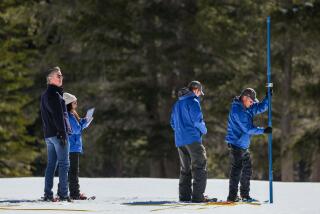Turning the tide in the water crisis
- Share via
The wildfires that have burned more than 1 million acres are the most visible symptom of another long, hot, dry summer in California. Less visible, though no less devastating, are the effects that the prolonged drought has on the state’s water supply and environment.
Although no one disagrees on the urgent need to fight the fires, there has long been sharp disagreement about how to address California’s chronic water shortage.
The time has come to break the stalemate.
So, in the spirit of bipartisan cooperation, earlier this month we offered a compromise water bond package for the Legislature’s consideration. We believe it is critical that the Legislature act swiftly to place such a measure on the November ballot.
Why the hurry? Put simply, our water supply is in jeopardy. We are experiencing the second year of drought, and 2008 had the driest spring ever recorded in the northern Sierra and other parts of Northern California. If the dry conditions continue into next year, we could be facing the worst drought in California history.
California depends on water from three primary sources: The Sierra Nevada snowpack, the Colorado River and our existing water-storage system. Each of these sources faces unprecedented challenges.
The snowpack, which was measured at only 67% of normal in May, has become dangerously unreliable because of global warming. It is estimated that climate change will cause the state’s snowpack to drop by 25% to 40% by 2050.
The Colorado River Basin just experienced an eight-year drought, and the amount of water that California is allowed to take from the river has dropped by 18% from 2003.
Reservoirs are dangerously low statewide. Lake Oroville, California’s second-largest storage reservoir, will end this year with its lowest amount of water in more than 30 years. Shasta Reservoir, the state’s largest, is at 48% of capacity.
At the same time that our water reserves are low, the courts have ordered restrictions on how much water can be pumped out of the Sacramento-San Joaquin River Delta, reducing water supplies by 20% to 30%. Just last week, a judge ordered state and federal regulators to come up with a plan to provide more water for salmon in the delta. This interim plan likely will require more reductions in pumping this winter.
Another year of drought will be catastrophic for our water supply, our environment and our economy. Already, farmers are taking agricultural lands out of production, and building permits could be put on hold, causing the loss of thousands of jobs.
The crisis is also causing catastrophic harm to our fisheries. In two of the last three years, our once-thriving Pacific salmon fisheries have been shut down as salmon populations have diminished.
Clearly, the state is in crisis. Yet, to this point, we’ve been unable to forge a common path forward.
For the last 18 months, the two of us have worked to develop a water infrastructure investment bond to put before California voters. We have listened carefully to legislative leaders and the many diverse stakeholders -- environmental and agricultural leaders, business, labor and urban and rural communities. We built on the areas of general agreement, and the common goal is clear: a clean and reliable water supply and healthy environment for the future of California.
Our hope is that the plan we have put together will serve as a solid starting point for negotiations with the Legislature.
Our proposal includes modernization of our aging water systems, significant investment in healing and safeguarding the Sacramento-San Joaquin River Delta and other important ecosystems, increased water storage in reservoirs and underground aquifers, improved conveyance and a strong focus on conservation programs.
We believe this is a balanced and comprehensive approach that will help meet the needs of a growing population -- expected to reach 50 million in the next decade. It will help us bank more water in wet years for use in the dry years. And it will meet our common goal of a healthy environment and reliable water supply.
Although there are efforts each year to address one piece of the puzzle or another, none of them has yet solved our crisis. What is needed is a comprehensive, statewide plan -- and we must move swiftly.
The impact of even one more dry season could be devastating -- we cannot afford to wait any longer.
More to Read
Sign up for Essential California
The most important California stories and recommendations in your inbox every morning.
You may occasionally receive promotional content from the Los Angeles Times.










